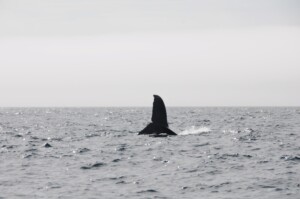10 Cool Things About Grey Whales
Every year, grey whales embark on an awe-inspiring journey from the warm waters of Mexico to the chilly feeding grounds of Alaska. This migration, spanning thousands of miles, is one of the most remarkable phenomena in the animal kingdom.

As winter approaches and food becomes scarce in the tropical breeding grounds, the whales begin their northward trek, driven by a primal instinct ingrained over millennia. Leaving behind the sheltered bays and lagoons of Mexico’s Pacific coast, they navigate through open seas, crossing vast expanses of ocean with determination and precision. Along the way, they encounter a myriad of challenges, from treacherous currents to potential threats from predators and human activities. Yet, their resilience and adaptability ensure their continued survival. Upon reaching the nutrient-rich waters of Alaska, they find respite and sustenance, feasting on mysid shrimp, amphipods, and small crustaceans to replenish their energy reserves and prepare for the breeding season ahead. Their annual pilgrimage is not just a testament to their physical prowess but also a reminder of the interconnectedness of ocean ecosystems and the importance of preserving these majestic creatures and their habitats for generations to come.
- Remarkable Migrations: Grey whales undertake one of the longest migrations of any mammal, traveling up to 19,000 kilometres round-trip between their breeding and feeding grounds, often along the Pacific coast of North America.
- Benthic Feeding Strategy: Gray whales are primarily benthic feeders, meaning they feed on organisms found on the ocean floor. They use their unique feeding method, known as “bottom feeding,” where they roll onto their sides and suck in sediment from the ocean floor, filtering out small crustaceans, mollusks, and other prey using their baleen plates.
- Unique Callosities: Grey whales have distinctive patches of roughened skin, called callosities, on their heads. These patches are inhabited by whale lice and barnacles, which give each whale a unique pattern used by researchers for identification.
- Friendly Encounters: Grey whales are known for their curious and friendly behaviour towards boats, often approaching vessels in a phenomenon known as “friendly interaction.” This behaviour has made them a favourite among whale watchers.
- Prehistoric Heritage: Grey whales are often referred to as “living fossils” due to their ancient lineage, which dates back over 30 million years. They are the sole surviving species in the family Eschrichtiidae.
- Eschrichtius robustus: The scientific name for the grey whale, Eschrichtius robustus, pays homage to the Danish zoologist Daniel Frederik Eschricht, who first described the species, and reflects their robust build.
- Deep Divers: While primarily coastal, grey whales are capable of diving to impressive depths of up to 150 meters (500 feet) when foraging for food.
- Social Creatures: Grey whales are often seen traveling in small groups or pods, typically consisting of a mother and calf or a few individuals. These social bonds are important for communication and protection during migration.
- Breaching Behaviour: Although less acrobatic than some other whale species, grey whales occasionally breach, lifting most of their body out of the water and crashing back down in a spectacular display thought to serve various purposes, including communication or parasite removal.
- Conservation Success Story: Once on the brink of extinction due to commercial whaling, grey whales have made a remarkable recovery since hunting bans were implemented in the 20th century. Today, they are considered a conservation success story and are protected under international law.
Want to check out some whales in real life? Now is the time to make your dreams come true!
Each spring, from March 16-24th, Tofino welcomes the Pacific Rim Whale Festival, an annual celebration of the great migration. Catch an event or Jump on a whale watching boat tour to find Grey Whales (Eschrichtius robustus), Humpback Whales (Megaptera novaeangliae), Orcas (Orcinus orca), or a catch a rare sighting of a Minke Whale (Balaenoptera acutorostrata). These whales, and the abundance and variety of coastal wildlife, make Tofino a prime destination for nature enthusiasts and those eager to witness the annual spectacle of migration and observe these magnificent creatures in their natural habitat.



